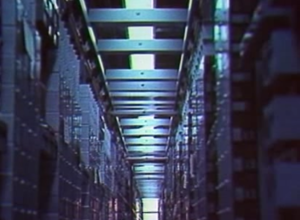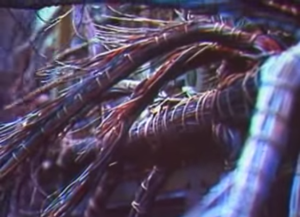 How many Ma Bell employees does it take to build an ESS mainframe? This week, Retrotechtacular takes you into the more poetic recesses of the AT&T Archive to answer that very question. This wordless 1974 gem is an 11-minute exploration of the construction and testing of a Western Electric 1ESS. It begins with circuit board population and ends with lots of testing.
How many Ma Bell employees does it take to build an ESS mainframe? This week, Retrotechtacular takes you into the more poetic recesses of the AT&T Archive to answer that very question. This wordless 1974 gem is an 11-minute exploration of the construction and testing of a Western Electric 1ESS. It begins with circuit board population and ends with lots of testing.

The film is really quite groovy, especially the extreme closeups of wire wrapping and relay construction. The soundtrack is a string-heavy suite that moves you through the phases of bringing up the 1ESS while drawing parallels to the wires of communication. You may lose count of the punch down blocks and miles of cables, but there are surprisingly few mustaches.
[Thank you, Tijmen for sending this in]
Retrotechtacular is a weekly column featuring hacks, technology, and kitsch from ages of yore. Help keep it fresh by sending in your ideas for future installments.















The amount of wire-wrapping within the individual frames before they’re moved to the site is something I’d forgotten! This was before the days of PCB panels the size of a door, and all the card-to-card backplane wiring was discrete. It was testable, repairable, and field-modifiable.
The last jobs I worked in wireline were replacing 1A’s, around 2002-2003, so I guess by now, the number still in service has fallen very close to zero. Technology marches on, but the amazing thing (to me) about an electronically-controlled switch is that, while the routing is done by a computer, the call paths are still mechanical, with relays clattering across the room to set up a single call, and releasing to tear it down again. During busy-hour they all overlap into a hailstorm of chattering chaos, but at night when things are slow, you can stand in the middle of the switch and hear an individual call, from the line equipment frame to the junctor frame to the terminating frame, with a few clicks of testing before final completion and ringing. A caller hanging up would release all that plus an additional click for the originating frame, which you didn’t hear during setup because the initial dialtone was removed in time by several seconds from the rest of the call setup.
Relay pull-in is louder than release, and one of the coolest things to hear is a failure — one of those testing steps discovers a problem at the last moment before the call connects, and the switch tries again a few times before giving up, releasing half the call path, and connecting it again a different way. A moment later you hear one of the teleprinters spit out a few lines of text, an order to a human to service the great machine.
When there are no calls being completed or torn down, the switch is silent, and to stand in the middle of such a beast and hear absolutely nothing is an eerie thing indeed. With fully-electronic switches there’s no such link between traffic and noise, Just fans. Try to imagine, those of you who’ve been in a datacenter, what such a facility would be like without a single cooling fan, with only a few (dozen?) watts of relay coils and hybrid circuit bias current per frame, with thousands of square feet occupied by a single machine and not an ethernet jack in sight anywhere. I hope some nostalgia for this equipment is understandable!
That’s a really cool description. Makes me imagine a cathedral to the machine spirits that chatter in answer to prayers.
I really enjoyed reading through that comment…
Thanks for that awesome comment Nate!
Wow. After your comment, I want to just camp out in one just feel the same way you illustrated it with your words. I’m a bit dumbfounded and in awe.
You made me travel in time, and imagine me inside this wonderful machine.
Great comment Nate, thanks.
and me as well!
thanks Nate!
Thank you for that. I think tour comment was probably better than the video.
What a great comment! My time wandering UK exchanges was later, 2000 onwards, but you still hear the dialtone / test relays clicking in & out on the line cards, and usually when you’re there to fix something you hear the automated test equipment relays chattering through their cycles.
The electrical engineering feats and concepts behind equipment like this are mind boggling, up there with the moon landings when you consider the sheer scale of the network, and sadly all too often hidden away or forgotten, known only to those who worked on them.
When you watch a video like this and several scenes provoke personal memories of, “dang I remember doing that job and it sucked,” you must be a fossil like me.
On the triple bay frames, with them being so heavy how would y’all move them around?
This is basically what I imagine happens inside of an FPGA every time you compile it.
That’s incredible! Really enjoyed this post.
This was 1974 and the teletypes they used had the letter O with a slash and the number 0 without. Today we’re having this reversed. Why and when did this switchover happen?
O slashed was an IBMism. DEC and the rest of the world slashed the 0.
Ya, I had a split second of confusion when I saw the first OK thinking it was zero K.
Wikipedia says it was an IBM convention.
Aha… IBM is the culprit. That sounds reasonable :-)
Of course there was few mustaches, they are low level grey beards in training!
For those that decry VoIP – te point is that on a one-for-one density to processing capability, serial digital switching of circuits like this is now around ONE BILLION times more effective !
I remember those days – and while it was nice to trace a wire from point to point, the newer solution is much more elegant – as long as you can handle the conceptual shift for designer, engineers and managers!
Keep in mind digital switching isn’t inherently IP. There’s plenty of TDM gear out there that fits in small places.
My problem with VoIP is on the consumer side. As a kid, it was always cool to me when the power would go out during a storm but the phone would still work just fine.
That bunch of wires at 4:25 is a real piece of modern art, would like to see one of those on the walls of a museum somewhere.
that used to be my source of protoboard wiring, several dozens of different color patterns!!
Looking at this and realizing this was cutting edge tech in 1974 I was struck by the thought, from writing to printing, semaphore, telegraph, radio, movies, television, the interwebs and of course telephone how much technological advancement has come just from people wanting to yak with one another.
For anyone wondering – without being able to violate my NDA, I can tell you that we still have the 1ESS switches in place today, and they run 24×7 with hardly any failures year round! 2 last year that I can remember, and 1 this year so far (one processor goes down, they failover to others…)
Transitioning these to more modern (7 year old) 4ESS is VERY slow :)
We have tried moving to the 5ESS switches, but orders (calls) were being dropped as the hardware is too bloody fast for the copper systems!
My 2 cents – sorry for the boring comment :D
In looking at the end credits, the cinematographer was Caleb Deschanel. Father of Emily and Zooey Deschanel.
People wouldn’t believe how loud relays were, servicing in a room (the size of a football-field) where a couple of 10000th of them work was no fun. Now you have that in a decent sized rack, altogether.
You might be interested in this, I found this while clicking around YouTube some time ago.
https://www.youtube.com/watch?v=gkXzljS74Nw
Well, that’s a rather noisy place, can’t be a nice place to work at.
Or one grows used to it and the sound just disappears.
That looks very similar to what I worked at, end of the 80th in Germany. Thanks for linking up! Hundereds of them https://www.youtube.com/watch?feature=player_embedded&v=Km1Bvd3pluQ
What’s amazing is the 1AESS, the slightly more modern version of the 1ESS, still runs to this day. Take a listen to this test announcement on one; 325-675-9818.
If your long distance carrier cuts through in time, you can hear a relay click loudly before the announcement rings. If not, there’s another after the announcement plays a few times, and it drops you over to reorder.
Here’s a list of that whole block if anybody is interested. There’s a few more recordings and other telco-related things in there; http://pastebin.com/XhumiwhJ
> 675-9880 – Please do not hang up. Your call is being forwarded over private facilities to an attended number. Any charges incured to the original number you dialed will apply.
Wow. That is an odd one.
Directly dumped from AT&T (http://techchannel.att.com) with rtmpdump utility
https://www.dropbox.com/s/cmbcoy3pqrt1sr6/AT%26T-the-hello-machine.flv
https://mega.co.nz/#!Zh8RlCDB!VFgTtQ6Gq4Q8zMzxAVE_YfAspfHo2l2eca0fJRC4Y3A
http://dfiles.eu/files/1gh4r44o4
This is the only film/video, in which I can
see my father, who passed away in 1978,
When I was 7 years old.
Thanks to all of you who made this possible.
C. E.